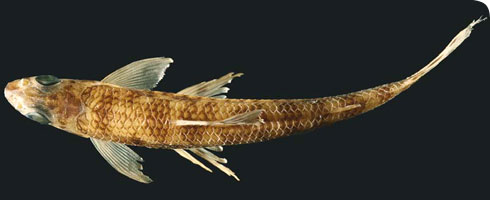Diagnostic description
Diagnosis
Nannocharax signifer is distinguished from all other Nannocharax species in West Africa by the red-orange colouration of the anterior part of its dorsal fin.
The combination of the following characters is also diagnostic:
- no continuous black band along the flank
- multiple x-shaped body colour pattern extending on the lower half of the flank
- 46-48 (usually 47) lateral line scales
- 4-5 scales between anus and origin of anal fin
Description
Based on holotype and twelve paratypes
- Size medium to large sized Nannocharax species with
- 60mm SL
- more than 70 mmTL.
- Body shape typical for Nannocharax:
- elongated with a slender body
- oval in cross section
- only slightly laterally compressed
- Head pointed, mouth small and subterminal
- Eye slightly closer to tip of snout than to end of head
- eye diameter about 1/3 of head length
- Body depth greatest directly in front of dorsal fin
- Body completely covered with ctenoid scales
- lateral line complete
- straight along body
- with 46 to 48, usually 47 scales
- 4.5 scale rows between lateral line and origin of dorsal fin
- 4.5 rows between lateral line and origin of pelvic fin
- 14 scale rows around caudal peduncle
- Dorsal fin
- at about middle of body
- with 3-4 simple rays of which
- 1-2 are supernumerary
- dorsal-fin origin at vertical through pelvic-fin origin or slightly behind.
- Caudal fin
- deeply bifurcate with equal lobes
- 9 dorsal procurrent rays
- 10 upper principal rays
- 9 lower principal rays
- 8 ventral procurrent rays
- Pectoral fin
- with 14-16 rays, usually 14
- tip of -fin behind origin of pelvic fin
- Pelvic fins
- well separated from each other, with 9 rays
- Anal fin
- with10-11 rays, usually 10
- Vertebrae
- Usually 38 vertebrae in total
- rarely 39
- 19 abdominal and 19 caudal vertebrae
